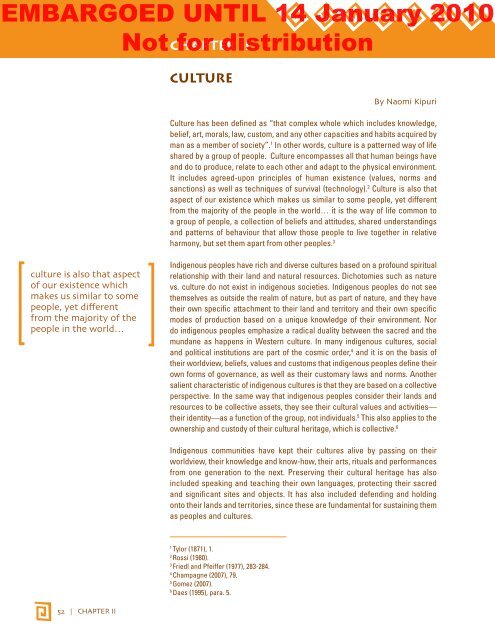STATE OF THE WORLD's INDIGENOUs PEOpLEs - CINU
STATE OF THE WORLD's INDIGENOUs PEOpLEs - CINU
STATE OF THE WORLD's INDIGENOUs PEOpLEs - CINU
- No tags were found...
Create successful ePaper yourself
Turn your PDF publications into a flip-book with our unique Google optimized e-Paper software.
EMBARGOED UNTIL 14 January 2010<strong>STATE</strong> <strong>OF</strong> <strong>THE</strong> WORLD’S INDIGENOUS PEOPLESNot CHAPTER for distributionIICULTUREBy Naomi KipuriCulture has been defined as “that complex whole which includes knowledge,belief, art, morals, law, custom, and any other capacities and habits acquired byman as a member of society”. 1 In other words, culture is a patterned way of lifeshared by a group of people. Culture encompasses all that human beings haveand do to produce, relate to each other and adapt to the physical environment.It includes agreed-upon principles of human existence (values, norms andsanctions) as well as techniques of survival (technology). 2 Culture is also thataspect of our existence which makes us similar to some people, yet differentfrom the majority of the people in the world… it is the way of life common toa group of people, a collection of beliefs and attitudes, shared understandingsand patterns of behaviour that allow those people to live together in relativeharmony, but set them apart from other peoples. 3culture is also that aspectof our existence whichmakes us similar to somepeople, yet differentfrom the majority of thepeople in the world…Indigenous peoples have rich and diverse cultures based on a profound spiritualrelationship with their land and natural resources. Dichotomies such as naturevs. culture do not exist in indigenous societies. Indigenous peoples do not seethemselves as outside the realm of nature, but as part of nature, and they havetheir own specific attachment to their land and territory and their own specificmodes of production based on a unique knowledge of their environment. Nordo indigenous peoples emphasize a radical duality between the sacred and themundane as happens in Western culture. In many indigenous cultures, socialand political institutions are part of the cosmic order, 4 and it is on the basis oftheir worldview, beliefs, values and customs that indigenous peoples define theirown forms of governance, as well as their customary laws and norms. Anothersalient characteristic of indigenous cultures is that they are based on a collectiveperspective. In the same way that indigenous peoples consider their lands andresources to be collective assets, they see their cultural values and activities—their identity—as a function of the group, not individuals. 5 This also applies to theownership and custody of their cultural heritage, which is collective. 6Indigenous communities have kept their cultures alive by passing on theirworldview, their knowledge and know-how, their arts, rituals and performancesfrom one generation to the next. Preserving their cultural heritage has alsoincluded speaking and teaching their own languages, protecting their sacredand significant sites and objects. It has also included defending and holdingonto their lands and territories, since these are fundamental for sustaining themas peoples and cultures.1Tylor (1871), 1.2Rossi (1980).3Friedl and Pfeiffer (1977), 283-284.4Champagne (2007), 79.5Gomez (2007).6Daes (1995), para. 5.52 | CHAPTER II
















